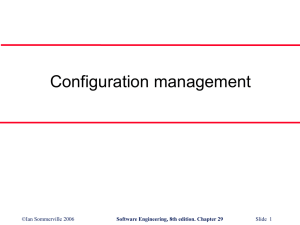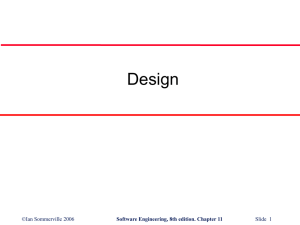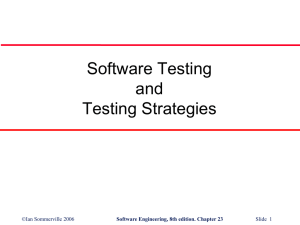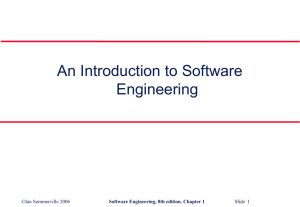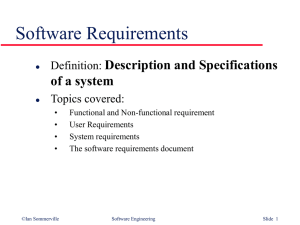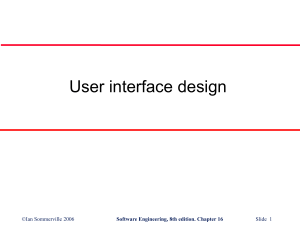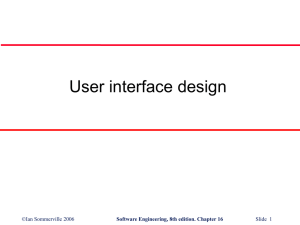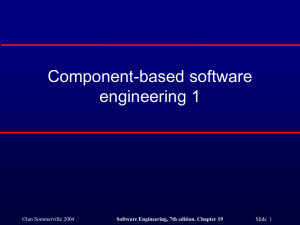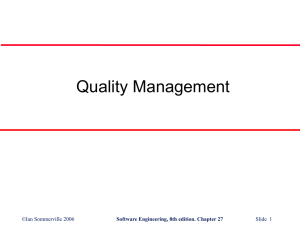Analysis Modeling
advertisement
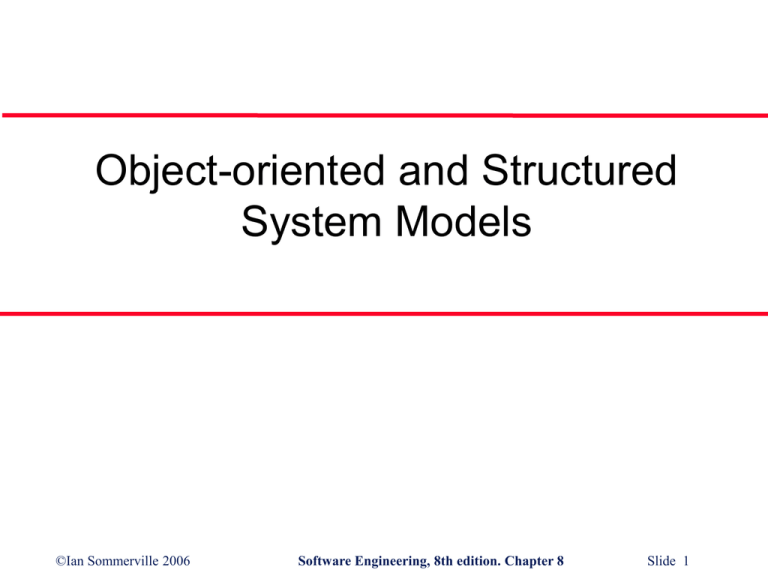
Object-oriented and Structured System Models ©Ian Sommerville 2006 Software Engineering, 8th edition. Chapter 8 Slide 1 Objectives To understand the context and the functionality of a system using different notations To review some structured notations To review some of the notations used in the Unified Modeling Language (UML) ©Ian Sommerville 2006 Software Engineering, 8th edition. Chapter 8 Slide 2 A Bridge s ys te m de s cription analys is m ode l de s ign m ode l ©Ian Sommerville 2006 Software Engineering, 8th edition. Chapter 8 Slide 3 3 System modeling Models are used to communicate with stakeholders. Different models present the system from different perspectives • • • External perspective showing the system’s context or environment; Behavioural perspective showing the behaviour of the system; Structural perspective showing the system or data architecture. ©Ian Sommerville 2006 Software Engineering, 8th edition. Chapter 8 Slide 4 Model types Data processing model shows how the data is processed at different stages. Composition model shows how entities are composed of other entities. Architectural model shows principal sub-systems. Classification model shows how entities have common characteristics. Stimulus/response model shows the system’s reaction to events. ©Ian Sommerville 2006 Software Engineering, 8th edition. Chapter 8 Slide 5 Data-processing models Data flow diagrams (DFDs) may be used to model the system’s data processing. • These show the processing steps as data flows through a system. DFDs are an intrinsic part of many analysis methods. • Simple and intuitive notation that customers can understand. ©Ian Sommerville 2006 Software Engineering, 8th edition. Chapter 8 Slide 6 Order processing DFD ©Ian Sommerville 2006 Software Engineering, 8th edition. Chapter 8 Slide 7 State machine models State machine models model the behaviour of the system in response to external and internal events/stimuli. • These show • • • often used for modelling real-time systems. system states as nodes events as arcs between nodes when an event occurs, the system moves from one state to another. Used a lot in UML ©Ian Sommerville 2006 Software Engineering, 8th edition. Chapter 8 Slide 8 The States of a System state —a set of observable circumstances that characterizes the behavior of a system at a given time state transition —the movement from one state to another event —an occurrence that causes the system to exhibit some predictable form of behavior action —process that occurs as a consequence of making a transition ©Ian Sommerville 2006 Software Engineering, 8th edition. Chapter 8 Slide 9 9 Microwave oven model ©Ian Sommerville 2006 Software Engineering, 8th edition. Chapter 8 Slide 10 Semantic data models Semantic data models describe the logical structure of data processed by the system. An entity-relation-attribute model sets out • • • the entities in the system, the relationships between these entities and the entity attributes Widely used in database design. Can readily be implemented using relational databases. No specific notation provided in the UML but objects and associations can be used (VERY SIMILAR to CLASS HIERARCHY DIAGRAMs) ©Ian Sommerville 2006 Software Engineering, 8th edition. Chapter 8 Slide 11 Example: Library semantic model ©Ian Sommerville 2006 Software Engineering, 8th edition. Chapter 8 Slide 12 Object models Object models describe the system in terms of object classes and their associations. An object class is an abstraction over a set of objects with common attributes and the services (operations) provided by each object. Various object models may be produced • • • • Simple object models Inheritance models Aggregation models Interaction models. ©Ian Sommerville 2006 Software Engineering, 8th edition. Chapter 8 Slide 13 Object Model: Class Diagram Class name System sy st emI D v erif icat ionPhoneNumber sy st emSt at us delay Time telephoneNumber mast erPassword temporary Password numberTries program() display () reset () query () modif y () call() ©Ian Sommerville 2006 attributes operations Software Engineering, 8th edition. Chapter 8 Slide 14 14 FloorPlan type name outsideDimensions Class (Relationship) Diagram determineType ( ) positionFloorplan scale( ) change color( ) is placed wit hin is part of Cam era Wall t ype ID locat ion f ieldV iew panA ngle Zoom Set t ing t ype wallDim ensions determineType ( ) computeDimensions ( ) det erm ineType () t ranslat eLocat ion () displayID() displayV iew() displayZoom () is used t o build is used t o build is used t o build WallSegm ent t ype st art Coordinat es st opCoordinat es next WallSem ent ©Ian Sommerville 2006 determineType ( ) draw( ) Window Door t ype st art Coordinat es st opCoordinat es next Window t ype st art Coordinat es st opCoordinat es next Door determineType ( ) draw( ) determineType ( ) draw( ) Software Engineering, 8th edition. Chapter 8 Slide 15 15 CRC Modeling Analysis classes have “responsibilities” • Responsibilities are the attributes and operations encapsulated by the class Analysis classes collaborate with one another • • Collaborators are those classes that are required to provide a class with the information needed to complete a responsibility. In general, a collaboration implies either a request for information or a request for some action. ©Ian Sommerville 2006 Software Engineering, 8th edition. Chapter 8 Slide 16 16 CRC Modeling Class: Class: Descript ion: Class: Descript ion: FloorPlan Class: Descript ion: Responsibility: Descript ion: Responsibility: Responsibility: Responsibility: Collaborator: Collaborator: Collaborator: Collaborator: def ines f loor plan name/ ty pe manages f loor plan posit ioning scales f loor plan f or display scales f loor plan f or display incorporat es walls, doors and windows Wall shows posit ion of v ideo cameras Camera ©Ian Sommerville 2006 Software Engineering, 8th edition. Chapter 8 Slide 17 17 Inheritance models Organize the domain object classes into a hierarchy. Classes at the top of the hierarchy reflect the common features of all classes. Object classes inherit their attributes and services from one or more super-classes. These may then be specialised as necessary. ©Ian Sommerville 2006 Software Engineering, 8th edition. Chapter 8 Slide 18 Library class hierarchy Library item Catalo g ue n u mb er Acq uis ition date Cos t Ty pe Statu s Number o f cop ies Acq uire () Catalo g ue () Disp os e () Is su e () Return () Pub lished item Recor d ed item Title Med iu m Title Pub lisher Boo k Au tho r Edition Pub lication da te ISBN ©Ian Sommerville 2006 Mag azine Year Is su e Film Directo r Date of releas e Distrib u tor Compu ter p ro gram Versio n Platfo rm Software Engineering, 8th edition. Chapter 8 Slide 19 User class hierarchy Library u ser Name Add res s Pho ne Reg is tration # Reg is ter () De-r eg is ter () Reader Borrower Items o n loan Max . loan s Affiliation Staff Dep ar tmen t Dep ar tmen t p ho n e ©Ian Sommerville 2006 Stud en t Majo r sub ject Home ad d res s Software Engineering, 8th edition. Chapter 8 Slide 20 Multiple inheritance Boo k Voice record in g Au tho r Edition Pub lication da te ISBN Speak er Duration Recor d ing d ate Talkin g bo ok # Tap es ©Ian Sommerville 2006 Software Engineering, 8th edition. Chapter 8 Slide 21 Object aggregation An aggregation model shows how classes that are collections are composed of other classes. Aggregation models are similar to the part-of relationship in semantic data models. ©Ian Sommerville 2006 Software Engineering, 8th edition. Chapter 8 Slide 22 Object aggregation ©Ian Sommerville 2006 Software Engineering, 8th edition. Chapter 8 Slide 23 Object behaviour modelling A behavioural model • • shows the interactions between objects to produce a behaviour that was specified as a use-case Collaboration diagrams in UML are used to model interaction between objects • Example: Sequence diagrams ©Ian Sommerville 2006 Software Engineering, 8th edition. Chapter 8 Slide 24 Sequence diagrams These show the sequence of events that take place during some user interaction with a system. You read them from top to bottom to see the order of the actions that take place. ©Ian Sommerville 2006 Software Engineering, 8th edition. Chapter 8 Slide 25 Sequence diagram of ATM withdrawal ATM Card P IN reques t Dat abase Card number Card OK P IN Validate card Option menu <<except ion>> inval id card Wit hdraw reques t Amount reques t Bal ance reques t Bal ance Handle request Amount Debi t (amount) <<except ion>> ins uffi ci ent cash Debi t res ponse Card Card removed Cas h ©Ian Sommerville 2006 Cas h removed Recei pt Complete trans action Software Engineering, 8th edition. Chapter 8 Slide 26
